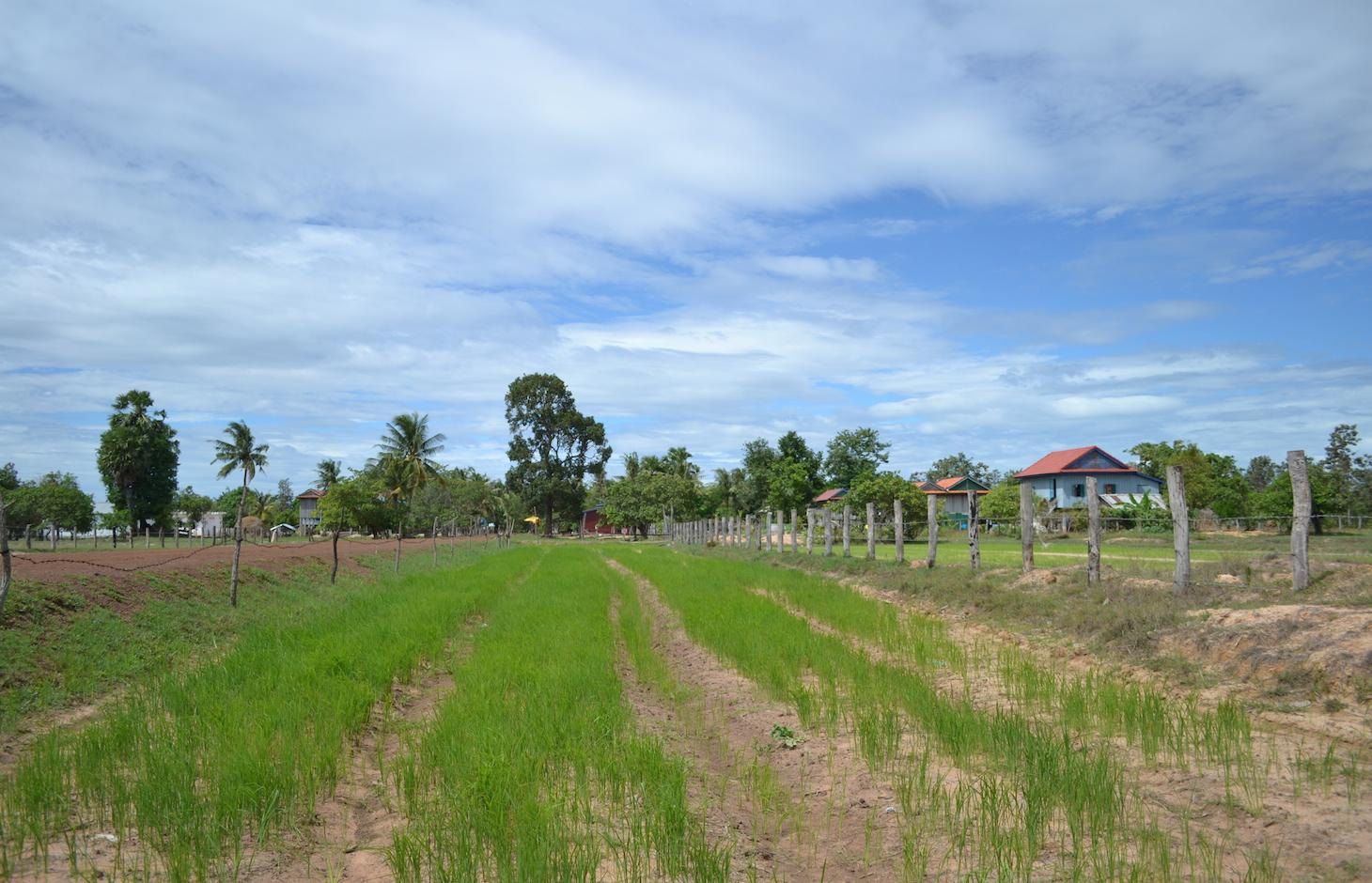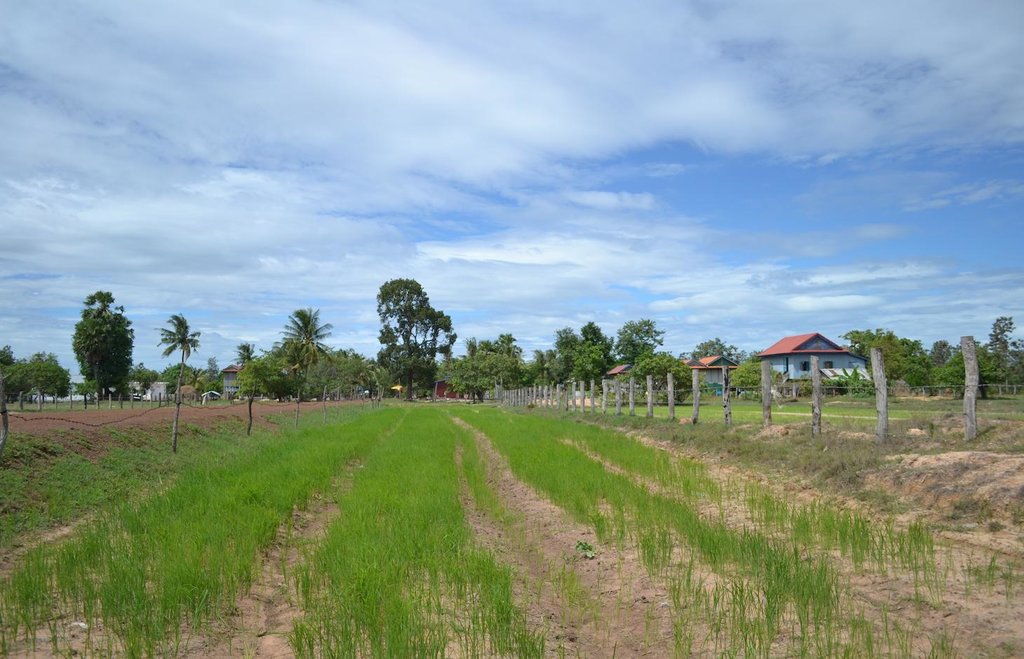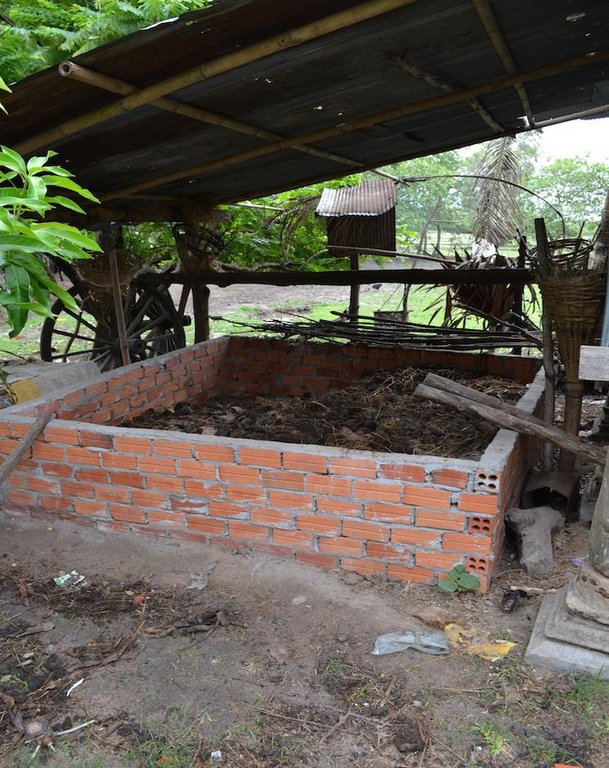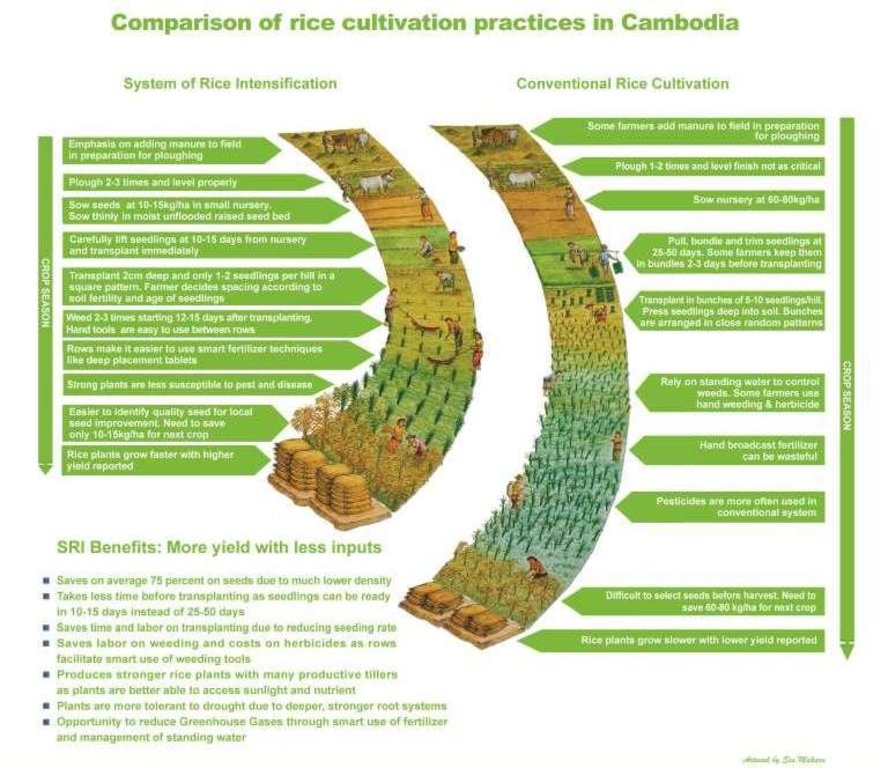Adapted System of Rice Intensification (SRI) principles in Kampong Chhnang [柬埔寨]
- 创建:
- 更新:
- 编制者: Christoph Kaufmann
- 编辑者: –
- 审查者: Deborah Niggli, Alexandra Gavilano
ការទទួលយកប្រពន្ធ័ប្រពលវប្បកម្មដំណំាស្រូវក្នុងខេត្តកំពុងឆ្នំាង (Khmer)
technologies_1224 - 柬埔寨
查看章节
全部展开 全部收起1. 一般信息
1.2 参与该技术评估和文件编制的资源人员和机构的联系方式
SLM专业人员:
Khun Lean Hak
SOFDEC/LAREC, www.sofdec.org
SLM专业人员:
SLM专业人员:
Say Mesa
SOFDEC
柬埔寨
SLM专业人员:
Bin Sreytouch
SOFDEC
柬埔寨
SLM专业人员:
Pith Khonhel
LAREC
柬埔寨
有助于对技术进行记录/评估的机构名称(如相关)
Local Agricultural Research and Extension Centre (LAREC) - 柬埔寨有助于对技术进行记录/评估的机构名称(如相关)
Society for Community Development in Cambodia (SOFDEC) - 柬埔寨1.3 关于使用通过WOCAT记录的数据的条件
编制者和关键资源人员接受有关使用通过WOCAT记录数据的条件。:
是
1.4 所述技术的可持续性声明
这里所描述的技术在土地退化方面是否存在问题,导致无法被认为是一种可持续的土地管理技术?:
否
1.5 参考关于SLM方法(使用WOCAT记录的SLM方法)的调查问卷
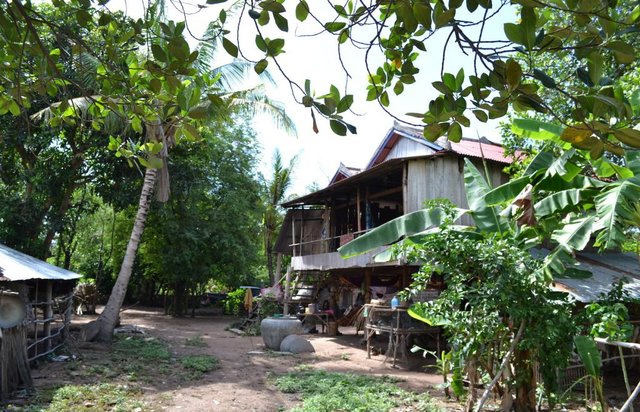
Model farmer [柬埔寨]
Model farms were introduced by a NGO in order to spread knowledge about SLM (compost, System of Rice Intensification SRI, and other technologies) in the project area.
- 编制者: Christoph Kaufmann
2. SLM技术的说明
2.1 技术简介
技术定义:
Some points of the System of Rice Intensification (SRI) technology, like the row transplanting of young seedlings and the use of compost are adapted and applied in Kampong Chhnang.
2.2 技术的详细说明
说明:
The System of Rice Intensification (SRI) was developed in the 1980s in Madagascar, where a French monk worked together with local farmers. The goals of the project were the improvement of the livelihoods of local farmers and the establishment of a farming system that is self-sufficient and thus needs no external inputs. SRI is not a recipe to be followed step by step, but general ideas that need to be adapted to the local conditions. These basic ideas are the following:
- Early transplanting of the seedlings, at the two-leaves-stage (less than 15 days after sowing). At this stage, the plant still has the potential to make a lot of tillers, and develop a strong root system. The seedlings are transplanted carefully, so the plant doesn’t suffer a transplanting shock.
- Wide spacing of single seedlings, usually in squares. The recommended spacing goes from 25 to 50 cm, depending on the soil fertility. This transplanting technique reduces the concurrence between the rice plants and allows the land user easier weeding.
- Aerating the soil. Rice is produced in standing water, but grows better if the roots are aerated. This is usually done with weeding, and additionally either by alternately flooding and letting the soil dry out, or by draining the water regularly. - The soil is fed with compost or manure in order to enhance the fertility and improve the soil structure.
SRI induces changes in deeply rooted local habits with some counter-intuitive knowledge like that more seeds do not produce more yields. Thus the methods have to be adapted locally and yields monitored to fit to other areas.
In Kampong Chhnang, the rice is transplanted at the six-leaves-stage, which is still earlier than conventional transplanting, with spacing of about 15 to 20 cm.
In Kampong Chhnang, the labour availability is low, as many young people work abroad or in the garment industry. Thus the SRI principles, which were taught by an NGO in 2004, were not followed completely, but adapted to this major constraint. The use of very young seedlings requires careful transplanting, which takes time. Thus the seedlings are transplanted at the 6 leaves stage. Due to the low soil fertility in the area, the optimal spacing as tested by CARDI (Cambodian Agricultural Research and Development Institute), was about 20 by 20 cm.
The rice seeds are soaked in water for 24 hours, and then let to germinate in a hot and humid place for two days. Then they are sown on the seed bed, which is prepared with compost. As there is not enough compost available for all the fields, the seedbed is the only place where compost is applied. In the fields chemical fertilizer is used. The seedlings are transplanted after 20 to 25 days (5-6 leaves) single or two per hill, in rows 15 to 20 cm apart. They are transplanted in better levelled fields than conventional transplanting, to allow the use of less water, as the seedlings are smaller than conventional. Otherwise the water management is the same as conventional; due to the lack of labour availability, the fields are not drained as proposed by the NGO 10 years ago. The field is weeded with hoes. The rice is harvested after 85 % of the panicle turned yellow, thus obtaining the best quality.
The analysed area is flat (slope < 2%), with a tropical climate (dry season from November to May and wet season from June to October), and the soils are mostly sandy or loamy. The soil has a low fertility, contains little organic matter, and acidifies. The area has been deforested a long time ago, and the groundwater table is rather high (1-2 m during the dry season, on the surface during wet season).
Due to climate change, farmers notice more erratic rainfalls, temperature rises and more recurrent droughts. Rice is the predominant crop grown in the area, since it serves as staple food (mix subsistence and commercial activities).
The increasing migration rate (the young generation leaves the villages to work in the cities, garment industry or abroad) results in a decrease of available labour force in the area which has detrimental effects on the agricultural activities. Furthermore, the civil war in the 1970s (Khmer Rouge) led to the loss of agricultural knowledge which different NGOs try to re-establish.
2.3 技术照片
2.5 已应用该技术的、本评估所涵盖的国家/地区/地点
国家:
柬埔寨
区域/州/省:
Kampong Chhnang
有关地点的进一步说明:
Cher Kroev
具体说明该技术的分布:
- 均匀地分布在一个区域
如果不知道精确的区域,请注明大致覆盖的区域:
- 10-100 平方千米
2.6 实施日期
如果不知道确切的年份,请说明大概的日期:
- 10-50年前
2.7 技术介绍
详细说明该技术是如何引入的:
- 通过项目/外部干预
注释(项目类型等):
In 2004, SRI was introduced to the land user of this case study by SOFDEC. Then the farmers adapted and transformed some steps.
3. SLM技术的分类
3.1 该技术的主要目的
- 改良生产
3.2 应用该技术的当前土地利用类型

农田
- 一年一作
- rice
每年的生长季节数:
- 1
具体说明:
Longest growing period in days: 210, Longest growing period from month to month: June-December
注释:
Major land use problems (compiler’s opinion): Lack of organic matter, lack of water retention in soil, irregularity of rainfall, low soil fertility (sandy soil), monocultures, bare soil during dry season, ploughing.
Major land use problems (land users’ perception): Low soil fertility, sandy soil with low water retention.
3.4 供水
该技术所应用土地的供水:
- 混合雨水灌溉
3.5 该技术所属的SLM组
- 土壤肥力综合管理
3.6 包含该技术的可持续土地管理措施

农艺措施
- A1:植被和土壤覆盖层
- A2:有机质/土壤肥力
注释:
Type of agronomic measures: better crop cover, manure / compost / residues
3.7 该技术强调的主要土地退化类型

化学性土壤退化
- Cn:肥力下降和有机质含量下降(非侵蚀所致)
- Ca:酸化
注释:
Main causes of degradation: soil management (The soil is ploughed and left bare for weeks in the dry season), crop management (annual, perennial, tree/shrub) (Rice monocultures), over-exploitation of vegetation for domestic use (No organic matter is left on the fields), labour availability (High migration rates.), education, access to knowledge and support services (Khmer Rouge regime led to the loss of agricultural knowledge.)
3.8 防止、减少或恢复土地退化
具体数量名该技术与土地退化有关的目标:
- 防止土地退化
- 减少土地退化
4. 技术规范、实施活动、投入和成本
4.1 该技术的技术图纸
技术规范(与技术图纸相关):
Cambodia
Date: 25.10.2011
Technical knowledge required for field staff / advisors: high
Technical knowledge required for land users: moderate
Main technical functions: increase in nutrient availability (supply, recycling,…)
Secondary technical functions: increase in organic matter
Better crop cover
Material/ species: Rice
Remarks: Single or 2 young rice seedlings per hill, in rows, space 15-20 cm
Manure / compost / residues
Material/ species: 2 – 3 t of compost for the seed bed (0.25 ha, transplanted on 1 ha), 75 kg/ha after transplanting.
Quantity/ density: 2-3 t
作者:
Luy Pisey Rith, Oxfam America, #94, Russian Boulevard, Sangkat Teuk Laak I, Khan Toul Kork, Phnom Penh, Cambodia
4.2 有关投入和成本计算的一般信息
注明雇用劳工的每日平均工资成本:
4.50
4.4 技术建立所需要的费用和投入
| 对投入进行具体说明 | 单位 | 数量 | 单位成本 | 每项投入的总成本 | 土地使用者承担的成本% | |
|---|---|---|---|---|---|---|
| 设备 | Compost house | 1.0 | 15.0 | 15.0 | 33.0 | |
| 技术建立所需总成本 | 15.0 | |||||
| 技术建立总成本,美元 | 15.0 | |||||
4.5 维护/经常性活动
| 活动 | 时间/频率 | |
|---|---|---|
| 1. | Ploughing the seed bed (either part of the paddy fields or different field) | 1 / year |
| 2. | Put seeds 24 hours in water | 1 / year |
| 3. | Cover the seeds in a warm place for incubation until they sprout (approximately 2 days, temperatures between 37-40 °C), plant the seedlings in seed bed and let them grow for about 20 - 25 days | 1 / year |
| 4. | Ploughing of rice paddy field | 2 / year |
| 5. | Pull the seedling from seed bed, row transplanting of young rice seedlings (20-25 days): 1-2 seedlings per hill, not too deep into the soil, in 1-2 cm of water. | 1 / year |
| 6. | Add chemical fertilizer to the paddy fields (20 days after transplanting) | 1 / year |
| 7. | Weed control (easier because of row transplanting), done manually | 2 / year |
| 8. | Harvest rice manually when plant is 85% mature. | 1 / year |
4.6 维护/经常性活动所需要的费用和投入(每年)
| 对投入进行具体说明 | 单位 | 数量 | 单位成本 | 每项投入的总成本 | 土地使用者承担的成本% | |
|---|---|---|---|---|---|---|
| 劳动力 | labour | ha | 1.0 | 228.0 | 228.0 | 100.0 |
| 设备 | animal traction | ha | 1.0 | 56.0 | 56.0 | 100.0 |
| 植物材料 | seeds | ha | 1.0 | 15.0 | 15.0 | 100.0 |
| 肥料和杀菌剂 | fertilizer | ha | 1.0 | 55.0 | 55.0 | 100.0 |
| 肥料和杀菌剂 | compost/manure | ha | 1.0 | 10.0 | 10.0 | 100.0 |
| 技术维护所需总成本 | 364.0 | |||||
| 技术维护总成本,美元 | 364.0 | |||||
注释:
Machinery/ tools: Plough; a hand weeder can be used for higher yields but not enough labour is available on the fields. 1 ha; farmer owns 2 ha; year 2014
4.7 影响成本的最重要因素
描述影响成本的最决定性因素:
The factor affecting the costs the most is the labour. SRI is labour intensive; the farmer needs twice as much time for a SRI field than for a conventional field. This is the reason he makes only a few of the steps he was taught 10 years ago by SOFDEC.
5. 自然和人文环境
5.1 气候
年降雨量
- < 250毫米
- 251-500毫米
- 501-750毫米
- 751-1,000毫米
- 1,001-1,500毫米
- 1,501-2,000毫米
- 2,001-3,000毫米
- 3,001-4,000毫米
- > 4,000毫米
有关降雨的规范/注释:
1486.45 mm 2013 in Kampong Chhnang
农业气候带
- 半湿润
Thermal climate class: tropics. 27-35°C
5.2 地形
平均坡度:
- 水平(0-2%)
- 缓降(3-5%)
- 平缓(6-10%)
- 滚坡(11-15%)
- 崎岖(16-30%)
- 陡峭(31-60%)
- 非常陡峭(>60%)
地形:
- 高原/平原
- 山脊
- 山坡
- 山地斜坡
- 麓坡
- 谷底
垂直分布带:
- 0-100 m a.s.l.
- 101-500 m a.s.l.
- 501-1,000 m a.s.l.
- 1,001-1,500 m a.s.l.
- 1,501-2,000 m a.s.l.
- 2,001-2,500 m a.s.l.
- 2,501-3,000 m a.s.l.
- 3,001-4,000 m a.s.l.
- > 4,000 m a.s.l.
5.3 土壤
平均土层深度:
- 非常浅(0-20厘米)
- 浅(21-50厘米)
- 中等深度(51-80厘米)
- 深(81-120厘米)
- 非常深(> 120厘米)
土壤质地(表土):
- 粗粒/轻(砂质)
- 中粒(壤土、粉土)
表土有机质:
- 中(1-3%)
- 低(<1%)
5.4 水资源可用性和质量
地下水位表:
< 5米
地表水的可用性:
匮乏/没有
水质(未处理):
不良饮用水(需要处理)
关于水质和水量的注释和进一步规范:
Ground water table: during dry season
Availability of surface water: during dry season
5.5 生物多样性
物种多样性:
- 低
5.6 应用该技术的土地使用者的特征
生产系统的市场定位:
- 混合(生计/商业)
非农收入:
- 收入的10-50%
相对财富水平:
- 贫瘠
- 平均水平
个人或集体:
- 个人/家庭
机械化水平:
- 手工作业
- 畜力牵引
性别:
- 女人
- 男人
说明土地使用者的其他有关特征:
Land users applying the Technology are mainly common / average land users
Population density: 10-50 persons/km2
Annual population growth: 0.5% - 1%
Off-farm income specification: Handicrafts, factory work, remittances
5.7 应用该技术的土地使用者使用的平均土地面积
- < 0.5 公顷
- 0.5-1 公顷
- 1-2 公顷
- 2-5公顷
- 5-15公顷
- 15-50公顷
- 50-100公顷
- 100-500公顷
- 500-1,000公顷
- 1,000-10,000公顷
- > 10,000公顷
这被认为是小规模、中规模还是大规模的(参照当地实际情况)?:
- 小规模的
5.8 土地所有权、土地使用权和水使用权
土地所有权:
- 社区/村庄
- 个人,未命名
土地使用权:
- 社区(有组织)
- 个人
用水权:
- 自由进入(无组织)
注释:
Land users have a title that is not recognized by the state
5.9 进入服务和基础设施的通道
健康:
- 贫瘠
- 适度的
- 好
教育:
- 贫瘠
- 适度的
- 好
技术援助:
- 贫瘠
- 适度的
- 好
就业(例如非农):
- 贫瘠
- 适度的
- 好
市场:
- 贫瘠
- 适度的
- 好
能源:
- 贫瘠
- 适度的
- 好
道路和交通:
- 贫瘠
- 适度的
- 好
饮用水和卫生设施:
- 贫瘠
- 适度的
- 好
金融服务:
- 贫瘠
- 适度的
- 好
6. 影响和结论性说明
6.1 该技术的现场影响
社会经济效应
生产
作物生产
注释/具体说明:
Around 20% more yields
生产故障风险
注释/具体说明:
Seedbed can be irrigated
水资源可用性和质量
灌溉用水需求
注释/具体说明:
The seedbed is smaller, so less irrigation is needed in the beginning of the rainy season/dry spell
收入和成本
农业投入费用
注释/具体说明:
Used half the amount of seeds
农业收入
工作量
社会文化影响
食品安全/自给自足
注释/具体说明:
Crop is more tolerant to droughts. He uses less chemical fertilizer since he uses compost
SLM/土地退化知识
注释/具体说明:
Knowledge about composting
冲突缓解
contribution to human well-being
注释/具体说明:
SRI increased the rice yields and reduces the use of seeds.
生态影响
土壤
土壤有机物/地下C
注释/具体说明:
Compost only used in seedbed
6.3 技术对渐变气候以及与气候相关的极端情况/灾害的暴露和敏感性(土地使用者认为的极端情况/灾害)
渐变气候
渐变气候
| 季节 | 增加或减少 | 该技术是如何应对的? | |
|---|---|---|---|
| 年温度 | 增加 | 未知 |
气候有关的极端情况(灾害)
气象灾害
| 该技术是如何应对的? | |
|---|---|
| 局地暴雨 | 好 |
| 局地风暴 | 未知 |
气候灾害
| 该技术是如何应对的? | |
|---|---|
| 干旱 | 好 |
水文灾害
| 该技术是如何应对的? | |
|---|---|
| 比较和缓的(河道)洪水 | 不好 |
其他气候相关的后果
其他气候相关的后果
| 该技术是如何应对的? | |
|---|---|
| 缩短生长期 | 未知 |
6.4 成本效益分析
技术收益与技术建立成本相比如何(从土地使用者的角度看)?
短期回报:
积极
长期回报:
非常积极
技术收益与技术维护成本/经常性成本相比如何(从土地使用者的角度看)?
短期回报:
积极
长期回报:
非常积极
注释:
The building of the compost house (only establishment cost) was subsidized, so he had to pay only 5 $ to build it. On the long term the addition of compost is very positive for the soil fertility.
6.5 技术采用
在所有采用这项技术的人当中,有多少人是自发的,即未获得任何物质奖励/付款?:
- 11-50%
注释:
67% of land user families have adopted the Technology with external material support
33% of land user families have adopted the Technology without any external material support
20 land user families have adopted the Technology with external material support
10 land user families have adopted the Technology without any external material support
Due to the lack of labour force less farmers are applying the SRI technology.
6.7 该技术的优点/长处/机会
| 土地使用者眼中的长处/优势/机会 |
|---|
| Improved soil structure and fertility due to the compost addition. |
| 编制者或其他关键资源人员认为的长处/优势/机会 |
|---|
| Improved yields (ca. 20%) |
| Better price possible if he applied SRI without chemical fertilizer and if he sold the yield on the organic market. |
6.8 技术的弱点/缺点/风险及其克服方法
| 土地使用者认为的弱点/缺点/风险 | 如何克服它们? |
|---|---|
| The seedlings have to be treated with care. | More yields, less dependent on off-farm income. |
| Increases the workload. | Change the local agriculture to more perennials and animals to produce more organic matter (shift toward integrated farming). |
| SRI needs more compost than is available. |
| 编制者或其他关键资源人员认为的弱点/缺点/风险 | 如何克服它们? |
|---|---|
| The fields are always flooded, thus there are anaerobic conditions in the root area. | Either, the water can be drained before the rain, or the fields can alternatively be dried out and flooded. |
| The seedlings are much older at the 6 leaves stage than recommended by SRI. | Experiment with transplanting of younger seedlings. |
7. 参考和链接
7.1 信息的方法/来源
- 实地考察、实地调查
- 与土地使用者的访谈
(现场)数据是什么时候汇编的?:
03/07/2014
7.2 参考可用出版物
标题、作者、年份、ISBN:
List of documentation about SRI in English
可以从哪里获得?成本如何?
http://sri.ciifad.cornell.edu/extmats/index.html#english (free)
链接和模块
全部展开 全部收起链接

Model farmer [柬埔寨]
Model farms were introduced by a NGO in order to spread knowledge about SLM (compost, System of Rice Intensification SRI, and other technologies) in the project area.
- 编制者: Christoph Kaufmann
模块
无模块


